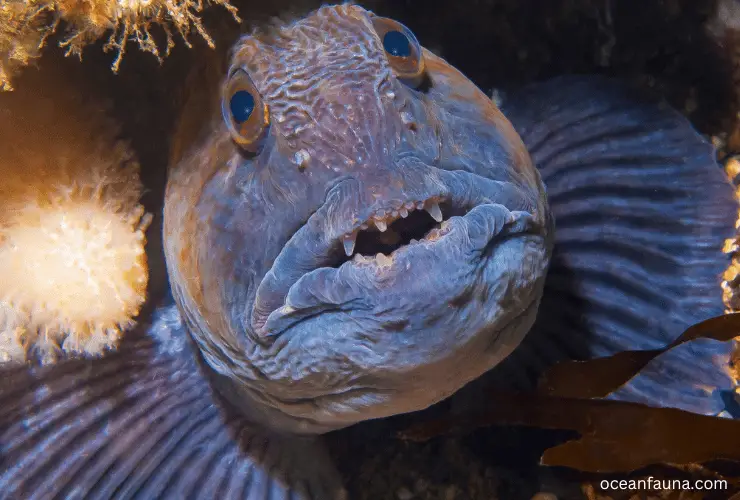Atlantic Wolffish, also commonly referred to as Seawolf, Devil Fish, Atlantic Catfish, Wold Eel, or Sea Cat, are members of the Anarhichadidae family and are found in the North Atlantic Ocean.
So many amazing facts are there about this wolffish. In this article, I will discuss them in detail.
About Atlantic Wolffish
| Category | Information |
| Common Names | Atlantic Wolffish |
| Other Names | Seawolf, Devil Fish, Atlantic Catfish, Wolf Eel, or Sea Cat |
| Scientific Name | Anarhichas lupus |
| Order | Perciformes |
| Family | Anarhichadidae |
| Diet | Mollusks, crustaceans, echinoderms, other fish, and sea urchins |
| Habitat | Deep, cold waters of the North Atlantic |
| Distribution | North Atlantic Ocean, from Greenland to New England |
| Size | Up to 5-6 feet |
| Weight | Up to 50 pounds |
| Life Expectancy | Up to 20 years |
| Reproduction | Internal Fertilization |
The Atlantic Wolffish is a large and formidable-looking predator that inhabits the cold waters of the North Atlantic Ocean, ranging from Labrador to North Carolina.
The Atlantic Wolffish is easily identified by its long, eel-like body shape, massive head, and intimidating teeth. They’re typically seen sporting colors of olive green, purplish-brown, or blue-gray – making them unmistakable in any aquatic environment.
It can grow up to 5-6 feet in length and weigh as much as 50 pounds, making it one of the largest fish species found in the North Atlantic.
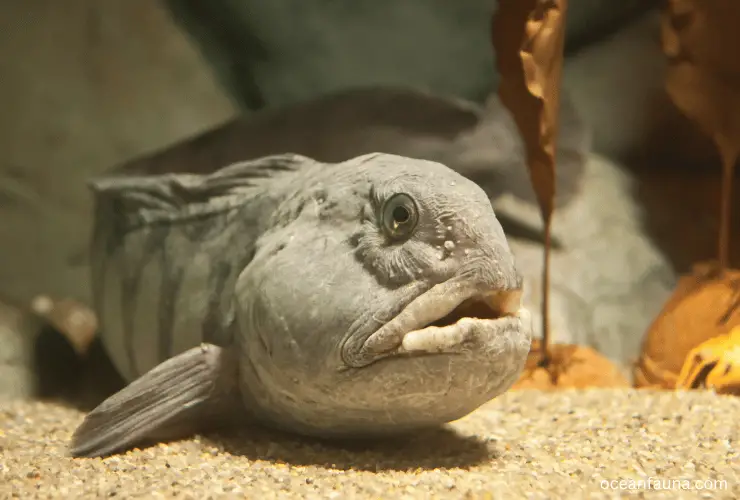
Despite its fearsome look, the Atlantic Wolffish is not considered dangerous to humans as it is not aggressive and rarely interacts with divers or swimmers. However, it is an important commercial fish that is prized for its delicate and flavorful flesh.
In addition to its economic value, the Atlantic Wolffish plays a crucial role in the ecology of the North Atlantic ecosystem. As an apex predator, it helps to regulate the population of its prey species, such as crabs, lobsters, and other fish. It also serves as a food source for other marine animals, such as seals and whales.
Unfortunately, the Atlantic Wolffish is currently listed as a species of concern by the National Marine Fisheries Service due to overfishing and habitat destruction. Its population has declined significantly in recent decades and is now considered endangered in some areas.
Conservation efforts are underway to restore populations and protect its habitat, which includes rocky reefs and deep-water canyons.
Fun Facts about Atlantic Wolffish
1. The Atlantic Wolffish is recognizable by its unique coloration and teeth, which are sharp and pointed like a wolf’s, which is also the reason for its name.
2. The fish are intimidating, but they are quite shy around humans.
3. Atlantic Wolffish have a complex reproductive cycle that involves both male and female parental care.
4. These fish can live up to 20 years in the wild and usually reach sexual maturity between 8 and 15 years of age.
5. The National Marine Fisheries Service has designated the Atlantic Wolffish as a species of concern due to its declining population.
6. Atlantic Wolffish can withstand cold temperatures, as low as -2 degrees Celsius (28.4F). This helps them survive in their deep-water habitats, where temperatures rarely rise above 4C (39.2F).
7. Atlantic Wolffish is a complete seawater fish, which means they can’t live in freshwater.
Anatomy of Atlantic Wolffish
Atlantic wolffish’s distinctive appearance and anatomy make it an interesting subject for study. In this article, we will explore their various anatomical systems of them in detail.
Skeletal System
The Atlantic Wolffish has a strong, bony skeleton that enables it to swim with great speed and agility. Its skeleton is composed of various bones and cartilage, including the cranium, jaw, and spinal column. The fish has sharp teeth embedded in its strong jaw, which help it catch prey.
Muscular System
The muscular system of the Atlantic Wolffish is well-developed, allowing it to swim and hunt with ease. The fish’s muscles are particularly strong in its tail, which is used for propulsion, and its jaws, which are used for biting and holding its prey.
Respiratory System
The Atlantic Wolffish has a unique respiratory system that allows it to extract oxygen from the water. Unlike most fish, which extract oxygen through gills, the wolffish has a specialized respiratory organ known as a “swim bladder” that helps it to regulate its buoyancy and extract oxygen from the water.
Digestive System
The Atlantic Wolffish has a well-developed digestive system that enables it to consume and digest a variety of prey. Its stomach is lined with strong muscles that help break down food, and its long intestine absorbs nutrients from the digested food.
Circulatory System
The circulatory system of the Atlantic Wolffish is complex and efficient, allowing it to transport oxygen and nutrients throughout its body. The fish has a two-chambered heart, with one chamber for pumping oxygen-depleted blood to the gills and another chamber for pumping oxygen-rich blood to the rest of the body.
How Atlantic Wolffish Gets Its Name?
The Atlantic Wolffish gets its name from its physical appearance and predatory nature. Its large, sharp teeth resemble those of a wolf, and its aggressive hunting behavior is similar to that of a wolf pack.
The scientific name for the Atlantic Wolffish is Anarhichas lupus, with “lupus” meaning “wolf” in Latin.
What Do Atlantic Wolffish Eat?
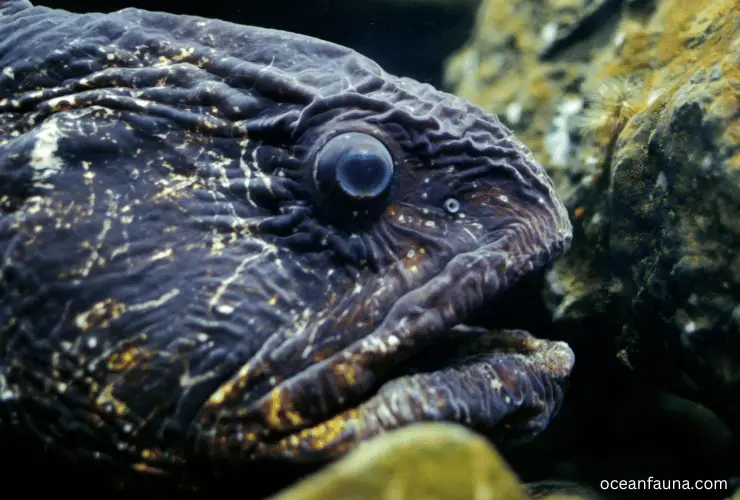
Atlantic wolffish are fierce predators that have evolved to consume hard-bodied or spiny invertebrates, which are often the toughest prey in the marine environment. Their massive heads, powerful jaws, and sharp canine teeth make them well-suited to hunting and eating prey that many other fish species can’t handle.
The main components of the wolffish diet include scallops, hermit crabs, Jonah crabs, sea urchins, and numerous other bottom-dwelling invertebrates. These creatures are rich sources of protein, fat, and other essential nutrients that are required for the survival and reproduction of the wolffish species.
To catch their prey, Atlantic wolffish typically use a hunting technique known as “ambush predation.” This involves lying in wait for their prey to come close and then lunging forward with lightning-fast speed to capture and consume it.
This technique is particularly well-suited to hunting bottom-dwelling creatures, as it allows the wolffish to strike from a position of relative safety while remaining hidden in the surrounding sediment.
Where Do Atlantic Wolffish Live?
The Atlantic wolffish is a species of fish that can be found along the Atlantic Coast of North America from Labrador to the Great South Channel and Georges Bank. These fish live in habitats consisting of boulder fields on rocky or hard clay bottoms of the continental shelf.
They prefer to inhabit areas with a depth of no more than 500 meters, and they thrive in cold to cool ocean waters.
The habitat of the Atlantic wolffish is unique and diverse. These fish require a particular type of substrate to live, such as rocky or hard clay bottoms. They often reside in boulder fields, providing shelter and protection from predators. These fish are also known to inhabit areas with steep drop-offs, where the water becomes deeper quickly.
The distribution of these fish is largely determined by their preference for specific geological features of the ocean floor.
They are found in relatively shallow waters along the coast of North America, where the continental shelf drops off into the deeper waters of the Atlantic Ocean. They are most commonly found in areas with high water flow and high dissolved oxygen levels.
In addition to their preferred habitat, Atlantic wolffish have also been found in estuarine areas, although this is less common. They are known to migrate inshore during the winter months and return to deeper waters as the weather warms up.
What Is the Lifespan of Atlantic Wolffish?
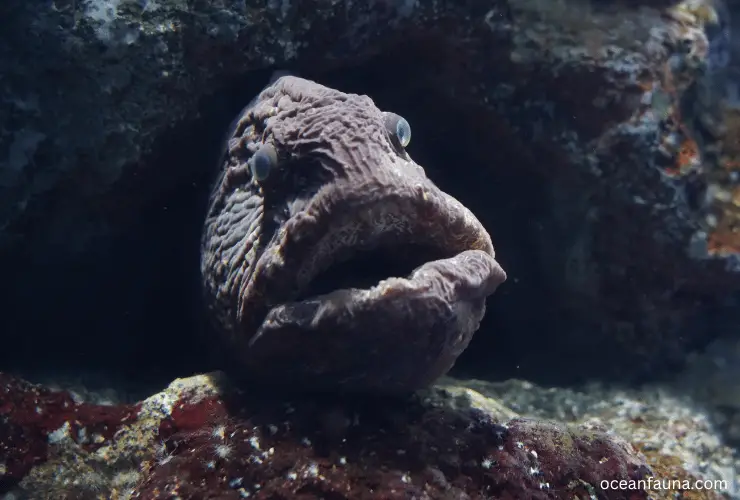
“How long does Atlantic wolffish live?” The Atlantic Wolffish has a relatively long lifespan compared to other fish species, typically living up to 20 years in the wild. These fish grow slowly, only reaching sexual maturity for females between the ages of 8 and 15 years.
Due to their slow growth, Atlantic Wolffish are also slow to reproduce. They spawn only once a year, typically in winter, and their eggs take several months to hatch.
Despite their relatively long lifespan, Atlantic Wolffish face threats from overfishing, habitat loss, and climate change. These factors have led to declines in their populations, which are now considered vulnerable or endangered in some areas.
How Do Atlantic Wolffish Reproduce?
The Atlantic Wolffish reproduce via internal fertilization, which is a common trait among many fish species. However, what sets them apart is their significant level of parental care.
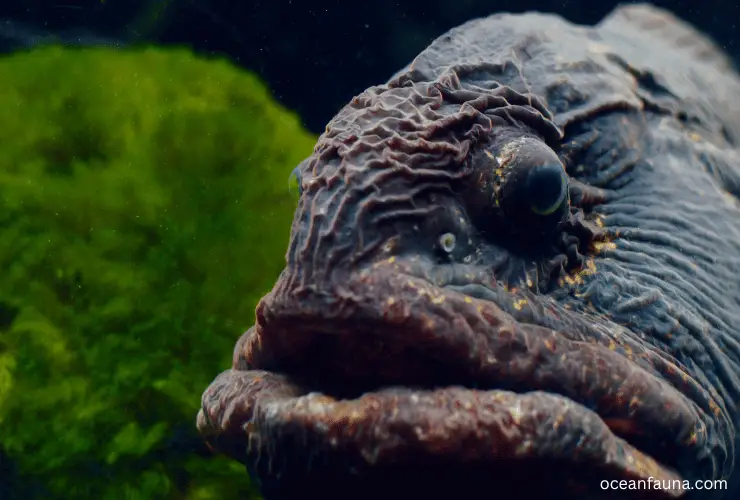
Females lay relatively large eggs, which both males and females then guard until they hatch. This high level of parental care is unusual among fish species, especially since both parents are involved in the process.
Interestingly, Atlantic Wolffish have been known to mate and nest in public aquariums, indicating that their reproductive behavior is somewhat adaptable to different environments.
The peak season for spawning is typically between September and October, and the eggs are laid in masses, which the males guard for an extended period, ranging from three to nine months until they hatch.
The males are incredibly protective of their young and will go to great lengths to defend their pups from potential predators. The level of dedication these fish demonstrate towards the care of their offspring is impressive, especially since it is not typical among fish species.
Are Atlantic Wolffish Aggressive to Humans?
Atlantic Wolffish may have a menacing appearance with their sharp teeth and rough exterior, but they are not typically aggressive towards humans. Unless provoked or threatened, they will generally avoid interactions with humans altogether.
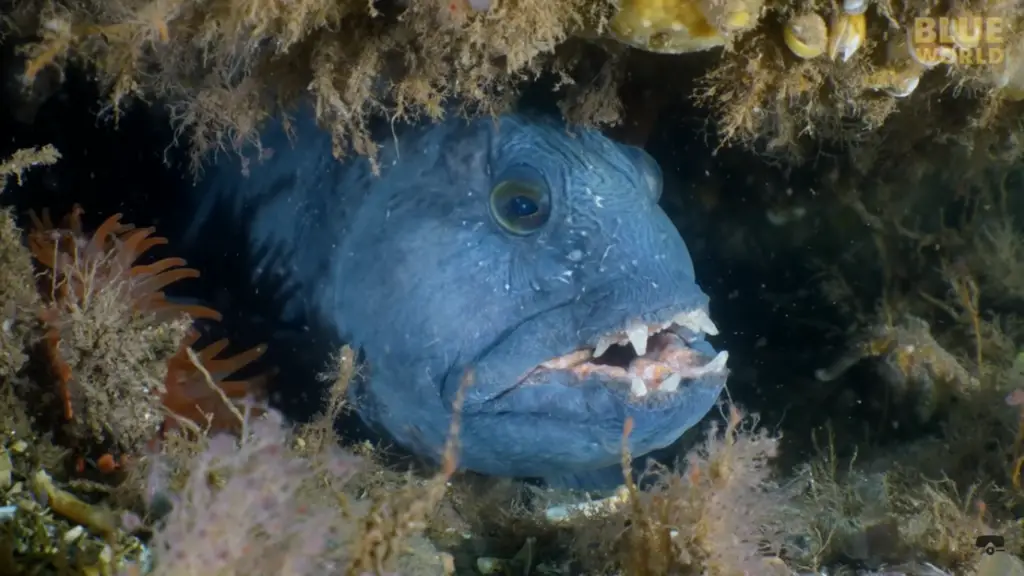
While they may defend themselves if they feel threatened, biting humans is not common for these fish.
However, it should be noted that, like any wild animal, they should be respected and given space. In areas where Atlantic Wolffish are known to live, it is recommended to maintain a safe distance and refrain from touching them.
Why Humans Catch Atlantic Wolffish?
Humans catch Atlantic Wolffish for various reasons, including commercial, recreational, and subsistence purposes. The fish is sought after for its meat, which is said to have a sweet and mild flavor, similar to lobster or crab.
Commercial fishing for Atlantic Wolffish began in the 1970s and 1980s, with mostly Canadian and Scandinavian fishermen targeting the species. The fish was initially caught as a bycatch in trawl fisheries, but its value as a food source led to targeted fisheries. The fish is now also caught in gillnet, longline, and trap fisheries.
Recreational anglers also target Atlantic Wolffish as a game fish. The species is known for its strong fight and large size, with some specimens reaching up to four feet in length and weighing over 50 pounds.
Catch-and-release fishing has become popular for this species, as it allows anglers to enjoy the sport without depleting the population.
In some coastal communities, Atlantic Wolffish is also caught for subsistence purposes. Indigenous peoples in Canada and Greenland have traditionally harvested fish for their meat, which is an important food source in their diets.
Conclusion
Now you have a compact knowledge of Atlantic wolffish. I have discussed here in detail their diet, habitat, anatomy, lifespan, reproduction system, and so on. Keep your question in the comment box if you want to know anything else about this fish.

